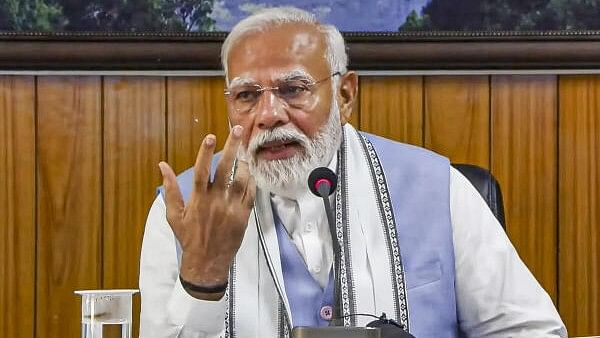
PM Narendra Modi
Credit: PTI Photo
A recent report authored by the Union Ministry of Statistics and Programme Implementation (MoSPI) provides some worrying statistics, not to mention the light it shines on the current regime’s unfortunate tendency of playing ducks and drakes with the well-entrenched statistical infrastructure that has until the past few years enjoyed an enviable global reputation.
It is important to note that the report, Women and Men in India 2023, published on August 12, is primarily focused on mapping gender relations and the information it packages for this document is meant to help delineate the relative positions of men and women in society, and the economic sphere. Moreover, the data presented in the report is culled from a variety of sources, rather than being generated independently through a research process. We shall have occasion to return to this issue.
Of consequence here, principally, is the finding that overall the fertility rate is going down, meaning, the rate of population growth is also going down. It has been projected that India’s population will stand at 1.522 billion in 2036 as against 1.211 billion in 2011, when the last decennial census was conducted and, therefore, for when accurate figures are available. In the meanwhile, we have the farcical situation of having to rely on a UN estimate to know that India became a more populous country than China in 2023. In April 2023, the UN Department of Social and Economic Affairs reported India was poised to overtake China in terms of population.
But that is not the important thing for our purposes. While the MoSPI report provides an encouraging indication that we may be turning the bend when it comes to badly skewed sex ratios, it also suggests that India’s population is ageing. The report says that while in 2011 women constituted 48.5 per cent of the population, in 2036 that proportion is going to go up to 48.8 per cent. It’s a small gain, but could signal that India is winning the war against female infanticide.
As mentioned, on the other hand, we are told that the proportion of people under 15 will decrease most ‘likely due to a declining fertility’, while the population aged 60 and over ‘is anticipated to substantially increase’ between 2011 and 2036, changing the shape of the demographic pyramid. This might not affect the working-age population in 2036, or even a few years after that, but in the long term it could mean that our much-cherished demographic dividend on which we bank so greatly for our growth and developmental push could dissipate in a couple of decades. The report says that while the working-age population was 60.7 per cent in 2011, it will rise to 64.9 per cent in 2036.
We shouldn’t be complacent. We have been told that fertility rates are going down in crucial age categories. In the age group 20-24, it’s gone down from 135.4 to 113.6, and in the age group 25-29 it’s gone down from 166 to 139.6. The fertility rate is marginally up in the 35-39 age group from 32.7 to 35.6. In the long term, we have cause for worry.
But more important is the fact that we are unable to exploit anywhere close to the fullest our current demographic dividend because poverty and lack of access to education and opportunity are stunting our youthful population as social and economic disparities continue to grow into an unbridgeable gulf. We should take care of that problem in the unsustainable present while we look ahead.
While it is critical that more inclusive policies are followed to realise the demographic dividend, pressure has to be brought to bear on the current regime to revive all the statistical studies that are critical to carrying on with the process of governance efficiently. Take, pre-eminently, the decennial census. Understandably, the operations were delayed in 2020 because of the pandemic. But four years have passed since then and we’re no nearer to getting the Census. In the meanwhile, a general election has been held and innumerable assembly elections. The green light has been shown to any number of public events, including massive religious congregations. There is no earthly reason for postponing the census.
One concrete outcome is that many who could have been included in the Union government’s free-grain scheme have fallen through the cracks. Another is that work on the delimitation process cannot begin without the census.
This government’s penchant for operating in grey areas of data, so it can always take recourse to falsehood, is contemptible.
(Suhit K Sen is author of ‘The Paradox of Populism: The Indira Gandhi Years, 1966-1977’.)
Disclaimer: The views expressed above are the author's own. They do not necessarily reflect the views of DH.